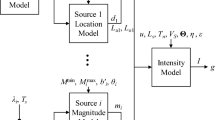Abstract
This chapter presents the general framework for systemic analysis of a set of interconnected civil infrastructural systems described in this book. While the relevant following chapters provide details on specific aspects of distributed seismic hazard (Chap. 3), vulnerability of components (the companion book), functional model of each system and their interactions (Chap. 5), and socio-economic impact evaluation (Chap. 4), this chapter focuses mainly on how the overall model has been developed according to the object-oriented paradigm, and on the way uncertainty in all factors is modelled.
Access this chapter
Tax calculation will be finalised at checkout
Purchases are for personal use only
Similar content being viewed by others
Notes
- 1.
The term ‘Infrastructure’ is a short-hand used in the following for the phrase ‘set of interconnected civil infrastructural systems’, this use being introduced first in (PCCIP 1997).
- 2.
The term ‘program’ is used here after Booch et~al. (2007). The modelling paradigm was born in the computer science community and it is intimately related to software design. This chapter, however, does not describe a software but, rather, the conceptual design of the platform-independent model that can (and indeed has been) implemented in a platform-specific application. This separation between platform-independent conceptual models and platform-specific implementation(s) is typical of the OOP.
- 3.
Figure 2.7 shows also a class not yet developed, included to allow for “generalized ground motion prediction models”, i.e. models that based on the same input of GMPE provide the full one- or multi-component time-series of motion at the site. The class is called GMTS, which stands for Ground Motion Time Series.
- 4.
Crowley and Bommer (2006) were probably the first to point out the need to use GMPEs with separate characterization of inter- and intra-event variability in the analysis of spatially distributed systems.
- 5.
Previous attempts to drastically reduce the number of scenarios to represent the regional seismicity, e.g. Shiraki et~al. (2007), were characterized by a more or less high degree of subjectivity.
- 6.
Kiremidjian et al. (2007) are the first to employ IS to selectively sample in the larger magnitude range.
References
Akkar S, Bommer JJ (2010) Empirical equations for the prediction of PGA, PGV and spectral accelerations in Europe, the Mediterranean Region, and the Middle East. Seismol Res Lett 81(2):195–206
ALA (American Lifelines Alliance) (2001) Seismic fragility formulations for water systems. Part 1 – Guideline. ASCE-FEMA, Reston, 104 pp
Ashby WR (1964) An introduction to cybernetics. Methuen, London
ATC (2007) Development of next generation performance-based seismic design procedures for new and existing buildings, Applied Technology Council, report no. ATC-58, Redwood City, CA
Booch G, Maksimchuk RA, Engle MW, Young BJ, Conallen J, Houston KA (2007) Object-oriented analysis and design with applications, 3rd edn. Addison Wesley, Reading
Chang SE, Chamberlin C (2004) Assessing the role of lifeline systems in community disaster resilience, MCEER research progress and accomplishments: 2003–2004, MCEER-04-SP01. MCEER, Buffalo, pp 87–94
Crowley H, Bommer JJ (2006) Modelling seismic hazard in earthquake loss models with spatially distributed exposure. Bull Earthq Eng 4(3):249–273
Der Kiureghian A (2009) Seismic risk assessment and management of infrastructure systems: re-view and new perspectives. In: Proceedings of the 10th international conference on structural safety and reliability, Osaka, Japan, 13–17 Sept
Dueñas-Osorio L, Craig JI, Goodno BJ (2007a) Seismic response of critical interdependent networks. Earthq Eng Struct Dyn 36:285–306
Dueñas-Osorio L, Craig JI, Goodno BJ, Bostrom A (2007b) Interdependent response of net-worked systems. ASCE J Infrastruct Syst 13:185–194
FEMA (2003) HAZUSMH MR4 multi-hazard loss estimation methodology – earthquake model – technical manual FEMA and NIBS, Washington, DC
Jayaram N, Baker JW (2010) Efficient sampling and data reduction techniques for probabilistic seismic lifelines assessment. Earthq Eng Struct Dyn 39(10):1109–1131
Kiremidjian AS, Stergiou E, Lee R (2007) Chapter 19: Issues in seismic risk assessment of transportation networks. In: Earthquake geotechnical engineering. Springer, Berlin, pp 939–964
McQueen JB (1967) Some methods for classification and analysis of multivariate observations. In: Proceedings of the 5th Berkeley symposium on mathematical statistics and probability, Berkeley, CA
Nielsen J (2007) Bayesian networks and decision graphs, 2nd edn. Springer, New York
PCCIP (1997) Critical foundations: protecting America’s infrastructures, report of the President’s Commission on critical infrastructure protection. Available from: http://www.fas.org/sgp/library/pccip.pdf. Last accessed 7 Sept 2011
Rubinstein RY (1981) Simulation and Monte Carlo method. Wiley, New York
Sánchez-Silva M, Gómez C (2013) Risk assessment and management of civil infrastructure networks: a systems approach. In: Tesfamariam S, Goda K (eds) Handbook of seismic risk analysis and management of civil infrastructure systems. Woodhead Publishing Limited, Cambridge/Philadelphia. doi:10.1533/9780857098986.4.437
Schläpfer M, Kessler T, Kröger W (2008) Reliability analysis of electric power systems using an object-oriented hybrid modeling approach. In: Proceedings of the 16th power systems computation conference, Glasgow, Scotland
Shiraki N, Shinozuka M, Moore JE II, Chang SE, Kameda H, Tanaka S (2007) System risk curves: probabilistic performance scenarios for highway networks subject to earthquake damage. J Infrastruct Syst 213(1):43–54
Straub D, Bensi M, Der Kiureghian A (2008) Spatial modelling of earthquake hazard and infrastructure performance through Bayesian network. In: Proceedings of the inaugural international conference of the Engineering Mechanics Institute ASCE, Minneapolis MN, USA, 19–21 May 2002
Author information
Authors and Affiliations
Corresponding author
Editor information
Editors and Affiliations
Rights and permissions
Copyright information
© 2014 Springer Science+Business Media Dordrecht
About this chapter
Cite this chapter
Franchin, P. (2014). A Computational Framework for Systemic Seismic Risk Analysis of Civil Infrastructural Systems. In: Pitilakis, K., Franchin, P., Khazai, B., Wenzel, H. (eds) SYNER-G: Systemic Seismic Vulnerability and Risk Assessment of Complex Urban, Utility, Lifeline Systems and Critical Facilities. Geotechnical, Geological and Earthquake Engineering, vol 31. Springer, Dordrecht. https://doi.org/10.1007/978-94-017-8835-9_2
Download citation
DOI: https://doi.org/10.1007/978-94-017-8835-9_2
Published:
Publisher Name: Springer, Dordrecht
Print ISBN: 978-94-017-8834-2
Online ISBN: 978-94-017-8835-9
eBook Packages: Earth and Environmental ScienceEarth and Environmental Science (R0)




